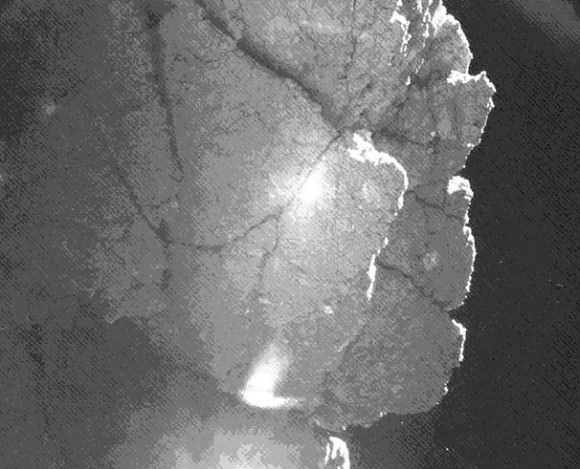Host: Fraser Cain (@fcain)
Guests:
Morgan Rehnberg (cosmicchatter.org / @cosmic_chatter)
Ramin Skibba (@raminskibba)
Alessondra Springmann (@sondy)
Continue reading “Weekly Space Hangout – Dec. 19, 2014: Methane on Mars!”

Space and astronomy news
Host: Fraser Cain (@fcain)
Guests:
Morgan Rehnberg (cosmicchatter.org / @cosmic_chatter)
Ramin Skibba (@raminskibba)
Alessondra Springmann (@sondy)
Continue reading “Weekly Space Hangout – Dec. 19, 2014: Methane on Mars!”
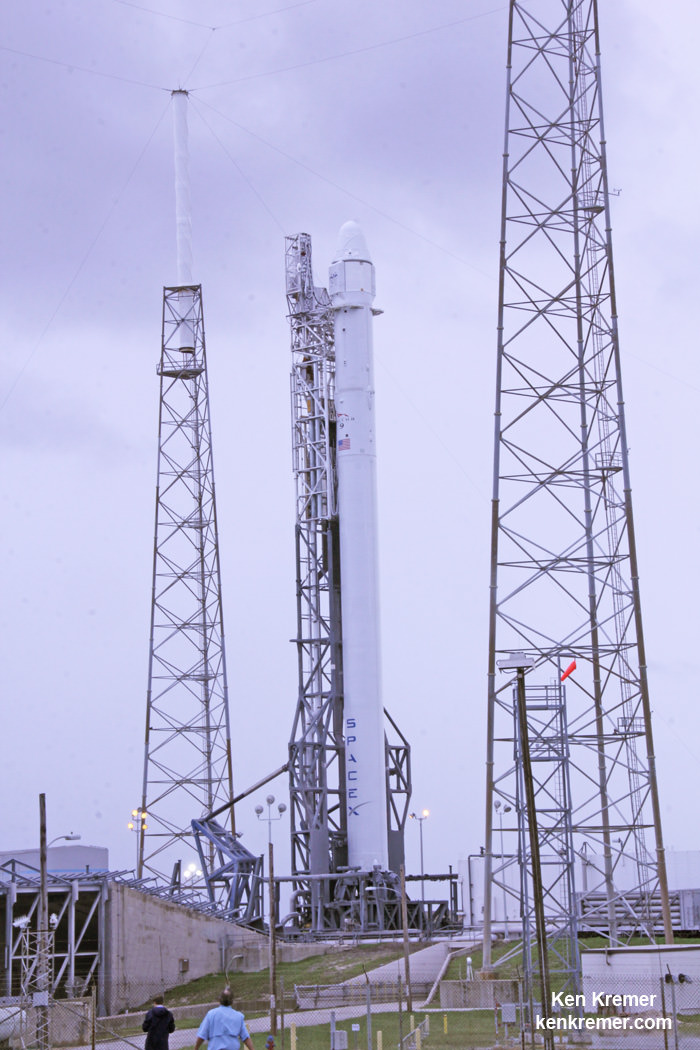
KENNEDY SPACE CENTER, FL – Due to technical problems encountered during a hot fire test of the first stage engines this week with the SpaceX Falcon 9 rocket, the planned Dec. 19 launch of the commercial rocket and NASA contracted Dragon cargo freighter to the International Space Station (ISS) on a critical resupply mission has been postponed a few weeks into the new year to Jan. 6 at the earliest “out of an abundance of caution,” SpaceX officials told Universe Today.
Prior to every launch, SpaceX performs an internally required full countdown dress rehearsal and hot fire test of the first stage propulsion systems.
The hot fire test attempted on Tuesday “did not run for its full duration” of about three seconds, SpaceX spokesman John Taylor confirmed to me.
Therefore SpaceX and NASA managers decided to postpone the launch in order to run another static fire test.
“We are opting to execute a second static fire test prior to launch,” Taylor said.
In light of the catastrophic failure of the Orbital Sciences Antares rocket and Cygnus cargo freighter, everything must be done to ensure a launch success.
Due to the large amount of work required to test and analyze all rocket systems and the impending Christmas holidays, the earliest opportunity to launch is Jan. 6.
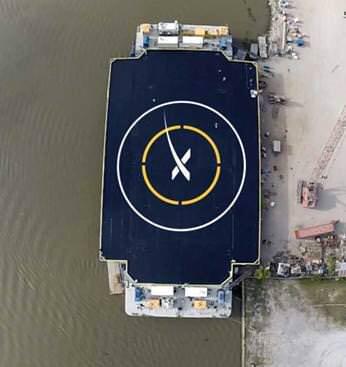
The SpaceX Falcon 9 rocket carrying the Dragon cargo freighter had been slated to liftoff on its next unmanned cargo run dubbed CRS-5 to the ISS under NASA’s Commercial Resupply Services (CRS) contract.
Here is the full update from SpaceX.
“While the recent static fire test accomplished nearly all of our goals, the test did not run the full duration. The data suggests we could push forward without a second attempt, but out of an abundance of caution, we are opting to execute a second static fire test prior to launch.”
“Given the extra time needed for data review and testing, coupled with the limited launch date availability due to the holidays and other restrictions, our earliest launch opportunity is now Jan. 6 with Jan. 7 as a backup.
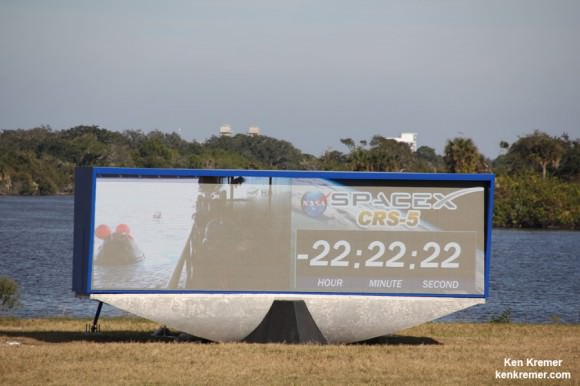
“The ISS orbits through a high beta angle period a few times a year. This is where the angle between the ISS orbital plane and the sun is high, resulting in the ISS’ being in almost constant sunlight for a 10 day period.
“During this time, there are thermal and operational constraints that prohibit Dragon from being allowed to berth with the ISS. This high beta period runs from 12/28/14-1/7/15”
“Note that for a launch on 1/6 , Dragon berths on 1/8.”
“Both Falcon 9 and Dragon remain in good health, and our teams are looking forward to launch just after the New Year.”
Watch for Ken’s ongoing SpaceX launch coverage from onsite at the Kennedy Space Center.
Stay tuned here for Ken’s continuing Earth and planetary science and human spaceflight news.
Earlier this month, delegates from the various states that make up the UN met in Lima, Peru, to agree on a framework for the Climate Change Conference that is scheduled to take place in Paris next year. For over two weeks, representatives debated and discussed the issue, which at times became hotly contested and divisive.
In the end, a compromise was reached between rich and developing nations, which found themselves on opposite sides for much of the proceedings.
And while few member states walked away feeling they had received all they wanted, many expressed that the meeting was an important step on the road to the 2015 Climate Change Conference. It is hoped that this conference will, after 20 years of negotiations, create the first binding and universal agreement on climate change.
The 2015 Paris Conference will be the 21st session of the Conference of the Parties who signed the 1992 United Nations Framework Convention on Climate Change (UNFCCC) and the 11th session of the Meeting of the Parties who drafted the 1997 Kyoto Protocol.
The objective of the conference is to achieve a legally binding and universal agreement on Climate Change specifically aimed at curbing greenhouse gas emissions to limit global temperature increases to an average of 2 degrees Celsius above pre-industrial levels.
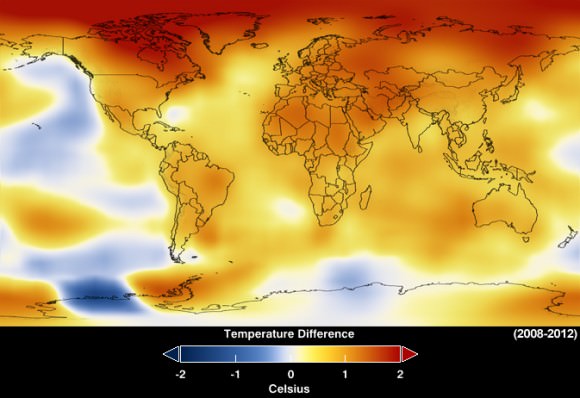
This temperature increase is being driven by increased carbon emissions that have been building steadily since the late 18th century and rapidly in the 20th. According to NASA, CO² concentrations have not exceeded 300 ppm in the upper atmosphere for over 400,000 years, which accounts for the whole of human history.
However, in May of last year, the National Oceanic and Atmospheric Administration (NOAA) announced that these concentrations had reached 400 ppm, based on ongoing observations from the Mauna Loa Observatory in Hawaii.
Meanwhile, research conducted by the U.S. Global Change Research Program indicates that by the year 2100, carbon dioxide emissions could either level off at about 550 ppm or rise to as high as 800. This could mean the difference between a temperature increase of 2.5 °C, which is sustainable, and an increase of 4.5 °C (4.5 – 8 °F), which would make life untenable for many regions of the planet.
Hence the importance of reaching, for the first time in over 20 years of UN negotiations, a binding and universal agreement on the climate that will involve all the nations of the world. And with the conclusion of the Lima Conference, the delegates have what they believe will be a sufficient framework for achieving that next year.
While many environmental groups see the framework as an ineffectual compromise, it was hailed by members of the EU as a step towards the long-awaited global climate deal that began in 1992.
“The decisions adopted in Lima pave the way for the adoption of a universal and meaningful agreement in 2015,” said UN Secretary-General Ban Ki-moon in a statement issued at the conclusion of the two-week meeting. In addition, Peru’s environment minister – Manuel Pulgar-Vidal, who chaired the summit – was quoted by the BBC as saying: “As a text it’s not perfect, but it includes the positions of the parties.”

Amongst the criticisms leveled by environmental groups is the fact that many important decisions were postponed, and that the draft agreement contained watered-down language.
For instance, on national pledges, it says that countries “may” include quantifiable information showing how they intend to meet their emissions targets, rather than “shall”. By making this optional, environmentalists believe that signatories will be entering into an agreement that is not binding and therefore has no teeth.
However, on the plus side, the agreement kept the 194 members together and on track for next year. Concerns over responsibilities between developed and developing nations were alleviated by changing the language in the agreement, stating that countries have “common but differentiated responsibilities”.
Other meaningful agreements were reached as well, which included boosted commitments to a Green Climate Fund (GCF), financial aid for “vulnerable nations”, new targets to be set for carbon emission reductions, a new process of Multilateral Assessment to achieve new levels of transparency for carbon-cutting initiatives, and new calls to raise awareness by putting climate change into school curricula.
In addition, the Lima Conference also led to the creation of The 1 Gigaton Coalition, a UN-coordinated group dedicated to promoting renewable energy. As stated by the UNEP, this group was created “to boost efforts to save billions of dollars and billions of tonnes of CO² emissions each year by measuring and reporting reductions of greenhouse gas emissions resulting from projects and programs that promote renewable energy and energy efficiency in developing countries.”
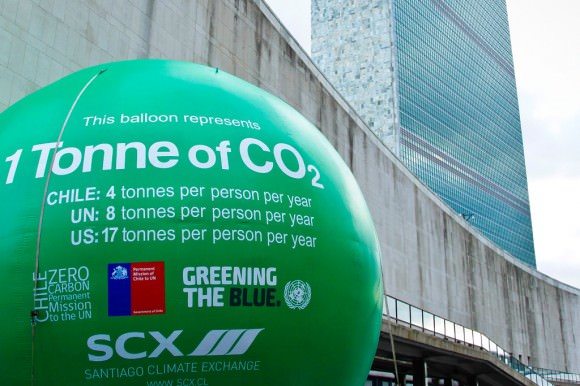
Coordinated by the United Nations Environment Programme (UNEP) with the support of the Government of Norway, they will be responsible for measuring CO² reductions through the application of renewable energy projects. The coalition was formed in light of the fact that while many nations have such initiatives in place, they are not measuring or reporting the drop in greenhouse gases that result.
They believe that, if accurately measured, these drops in emissions would equal 1 Gigaton by the year 2020. This would not only be beneficial to the environment, but would result in a reduced financial burden for governments all across the world.
As UNEP Executive Director Achim Steiner stated in a press release: “Our global economy could be $18 trillion better off by 2035 if we adopted energy efficiency as a first choice, while various estimates put the potential from energy efficient improvements anywhere between 2.5 and 6.8 gigatons of carbon per year by 2030.”
Ultimately, the 1 Gigaton Coalition hopes to provide the information that demonstrates unequivocally that energy efficiency and renewables are helping to close the gap between current emissions levels and what they will need to come down to if we hope to meet a temperature increase of just 2 °C. This, as already stated, could mean the difference between life and death for many people, and ultimately for the environment as a whole.
The location of UNFCCC talks are rotated by regions throughout United Nations countries. The 2015 conference will be held at Le Bourget from 30 November to 11 December 2015.

Call it holiday light creep. A NASA satellite has been tracking the spread of Christmas lighting from 512 miles up for the past three years and according to the data, nighttime lights around many major U.S. cities shine 20 to 50 percent brighter during Christmas and New Year’s when compared to light output during the rest of the year. Not surprisingly, most it comes from suburban areas.
Christmas isn’t the only time holiday festivities spill into the cosmic night. In some Middle Eastern Cities nighttime lights shine more than 50 percent brighter during Ramadan than the rest of the year. Because snow reflects so much light, the researchers could only analyze snow-free cities lest they risk comparing apples to oranges. The team focused on the U.S. West Coast from San Francisco to Los Angeles and on cities south of a rough line from St. Louis to Washington, D.C.
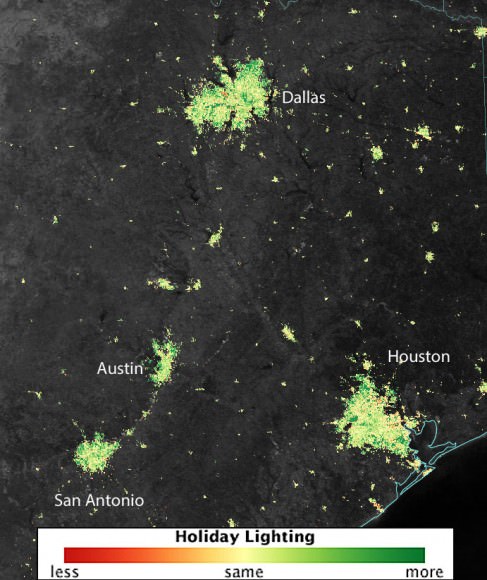
As someone who has spent many winter nights observing I can attest to snow being a major factor in nighttime sky brightness. Even downward shielded lighting must necessarily reflect upward and into the heavens when it strikes the snow below. Summer is a far darker time of year than winter across much of the northern U.S.

The orbital images were all taken by the Suomi NPP satellite, a joint NASA/National Oceanic and Atmospheric Administration mission, carries an instrument called the Visible Infrared Imaging Radiometer Suite (VIIRS) that detects light in a range of wavelengths from green to near-infrared as it flies over at roughly 1:30 a.m. and 1:30 p.m. each day. VIIRS has a low-light sensor that can distinguish night lights tens to hundreds of times better than previous satellites. In the U.S. the lights starting getting brighter the day after Thanksgiving and continued through News Year’s Day. Miguel Román, a scientist at NASA’s Goddard Space Flight Center and member of the Suomi NPP Land Discipline Team, made the discovery while researching urban energy use patterns in the context of greenhouse emissions. And you thought all those twinkly bulbs were just for fun.
NASA Sees Holiday Lights from Space
The science team found that light intensity increased by 30 to 50 percent in the suburbs and outskirts of major cities. Lights in the central urban areas didn’t increase as much as in the suburbs, but still brightened by 20 to 30 percent. This makes sense when you consider that folks in the ‘burbs not only decorate their homes but often extend Christmas displays across the yard and up into the trees.

Holiday lighting – a simple joy of the season. Yet it reflects both the hopes and wishes of human culture and the mundane facts of energy use. Through satellites, we can step back and watch the world change in ways never thought possible. We truly live in the Age of the Anthopocene, a newly designated era reflecting the profound effect our species has had and continues to have on the planet. To see all the holiday space photos, check out Goddard’s Flickr page.
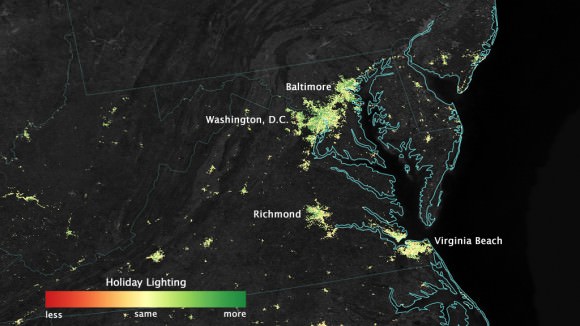
Venus really sucks. It’s as hot as an oven with a dense, poisonous atmosphere. But how did it get that way?
Venus sucks. Seriously, it’s the worst. The global temperature is as hot as an oven, the atmospheric pressure is 90 times Earth, and it rains sulfuric acid. Every part of the surface of Venus would kill you dead in moments.
Let’s push Venus into the Sun and be done with that terrible place. Its proximity is lowering our real estate values and who knows what sort of interstellar monstrosities are going to set up shop there, and be constantly knocking on our door to borrow the mower, or a cup or sugar, or sneak into our yard at night and eat all our dolphins.
You might argue that Venus is worth saving because it’s located within the Solar System’s habitable zone, that special place where water could exist in a liquid state on the surface. But we’re pretty sure it doesn’t have any liquid water. Venus may have been better in the past, clearly it started hanging out with wrong crowd, taking a bad turn down a dark road leading it to its current state of disrepair.
Could Venus have been better in the past? And how did it go so wrong? In many ways, Venus is a twin of the Earth. It’s almost the same size and mass as the Earth, and it’s made up of roughly the same elements. And if you stood on the surface of Venus, in the brief moments before you evacuated your bowels and died horribly, you’d notice the gravity feels pretty similar.
In the ancient past, the Sun was dimmer and cooler than it is now. Cool enough that Venus was much more similar to Earth with rivers, lakes and oceans. NASA’s Pioneer spacecraft probed beneath the planet’s thick clouds and revealed that there was once liquid water on the surface of Venus. And with liquid water, there could have been life on the surface and in those oceans.
Here’s where Venus went wrong. It’s about a third closer to the Sun than Earth, and gets roughly double the solar radiation. The Sun has been slowly heating up over the millions and billions of years. At some point, the planet reached a tipping point, where the water on the surface of Venus completely evaporated into the atmosphere.

Water vapor is a powerful greenhouse gas, and this only increased the global temperature, creating a runaway greenhouse effect on Venus. The ultraviolet light from the Sun split apart the water vapor into oxygen and hydrogen. The hydrogen was light enough to escape the atmosphere of Venus into space, while the oxygen recombined with carbon to form the thick carbon dioxide atmosphere we see today. Without that hydrogen, Venus’ water is never coming back.
Are you worried about our changing climate doing that here? Don’t panic. The amount of carbon dioxide released into the atmosphere of Venus is incomprehensible. According to the IPCC, the folks studying global warming, human activities have no chance of unleashing runaway global warming. We’ll just have the regular old, really awful global warming. So, it’s okay to panic a bit, but do it in the productive way that results in your driving your car less.
The Sun is still slowly heating up. And in a billion years or so, temperatures here will get hot enough to boil the oceans away. And then, Earth and Venus will be twins again and then we can push them both into the Sun.
I know, I said the words “climate change”. Feel free to have an argument in the comments below, but play nice and bring science.
It’s alive! NASA’s Kepler space telescope had to stop planet-hunting during Earth’s northern-hemisphere summer 2013 when a second of its four pointing devices (reaction wheels) failed. But using a new technique that takes advantage of the solar wind, Kepler has found its first exoplanet since the K2 mission was publicly proposed in November 2013.
And despite a loss of pointing precision, Kepler’s find was a smaller planet — a super-Earth! It’s likely a water world or a rocky core shrouded in a thick, Neptune-like atmosphere. Called HIP 116454b, it’s 2.5 times the size of Earth and a whopping 12 times the mass. It circles its dwarf star quickly, every 9.1 days, and is about 180 light-years from Earth.
“Like a phoenix rising from the ashes, Kepler has been reborn and is continuing to make discoveries. Even better, the planet it found is ripe for follow-up studies,” stated lead author Andrew Vanderburg of the Harvard-Smithsonian Center for Astrophysics.
Kepler ferrets out exoplanets from their parent stars while watching for transits — when a world passes across the face of its parent sun. This is easiest to find on huge planets that are orbiting dim stars, such as red dwarfs. The smaller the planet and/or brighter the star, the more difficult it is to view the tiny shadow.
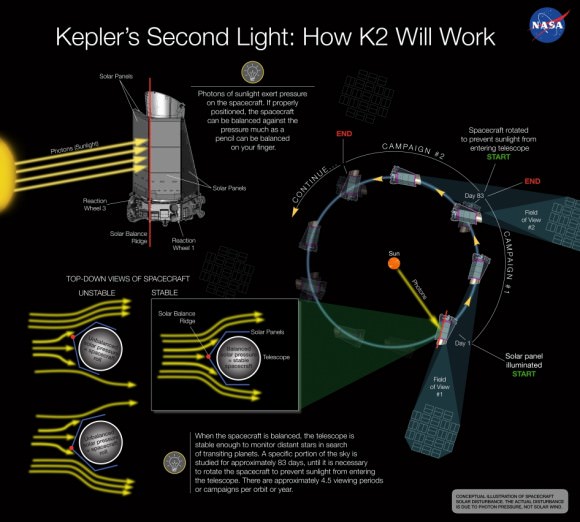
The telescope needs at least three reaction wheels to point consistently in space, which it did for four years, gazing at the Cygnus constellation. (And there’s still a lot of data to come from that mission, including the follow-up to a bonanza where Kepler detected hundreds of new exoplanets using a new technique for multiple-planet systems.)
But now, Kepler needs an extra hand to do so. Without a mechanic handy to send out to telescope’s orbit around the Sun, scientists decided instead to use sunlight pressure as a sort of “virtual” reaction wheel. The K2 mission underwent several tests and was approved budgetarily in May, through 2016.
The drawback is Kepler needs to change positions every 83 days since the Sun eventually gets in the telescope’s viewfinder; also, there are losses in precision compared to the original mission. The benefit is it can also observe objects such as supernovae and star clusters.
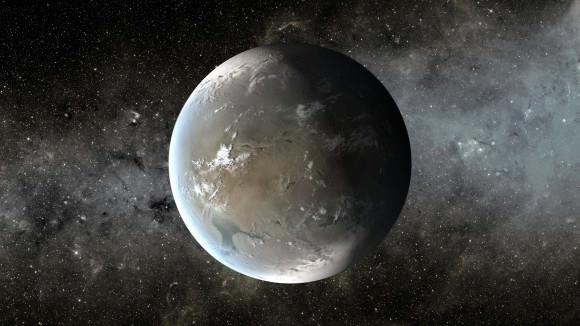
“Due to Kepler’s reduced pointing capabilities, extracting useful data requires sophisticated computer analysis,” CFA added in a statement. “Vanderburg and his colleagues developed specialized software to correct for spacecraft movements, achieving about half the photometric precision of the original Kepler mission.”
That said, the first nine-day test with K2 yielded one planetary transit that was confirmed with measurements of the star’s “wobble” as the planet tugged on it, using the HARPS-North spectrograph on the Telescopio Nazionale Galileo in the Canary Islands. A small Canadian satellite called MOST (Microvariability and Oscillations of STars) also found transits, albeit weakly.
A paper based on the research will appear in the Astrophysical Journal.
Short-period comet 15P/Finlay, which had been plunking along at a dim magnitude +11, has suddenly brightened in the past couple days to +8.7, bright enough to see in 10×50 or larger binoculars. Czech comet observer Jakub Cerny and his team photographed the comet on December 16th and discovered the sudden surge. Wonderful news!
While comets generally brighten as they approach the Sun and fade as they depart, any one of them can undergo a sudden outburst in brightness. You can find Finlay right now low in the southwestern sky at nightfall near the planet Mars. While outbursts are common, astronomers still aren’t certain what causes them. It’s thought that sub-surface ices, warmed by the comet’s approach to the Sun, expand until the pressure becomes so great they shatter the ice above, sending large fragments flying and exposing fresh new ice. Sunlight gets to work vaporizing both the newly exposed vents and aerial shrapnel. Large quantities of dust trapped in the ice are released and glow brightly in the Sun’s light, causing the comet to quickly brighten.
Some comets flare up dramatically. Take 29P/Schwassmann-Wachmann. Normally a dim bulb at 17th magnitude, once or twice a year it flares to magnitude 12 and occasionally 10!

Whatever the reason, outbursts can last from days to weeks. It’s anybody’s guess how long 15P/Finlay will remain a relatively easy target for comet hungry skywatchers. While not high in the sky, especially from the northern U.S., it can be seen during early evening hours if you plan well.
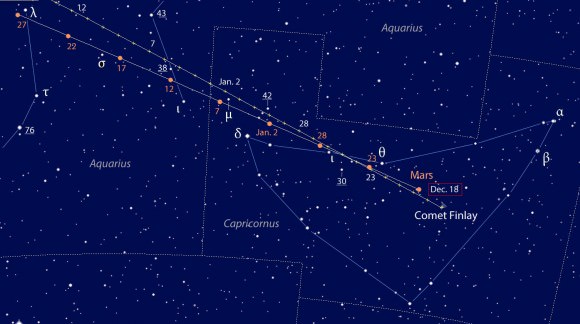
Comet Finlay was discovered by William Henry Finlay from South Africa on September 26, 1886. It reaches perihelion or closest approach to the Sun on December 27th and was expected to brighten to magnitude +10 when nearest Earth in mid-January at 130 million miles (209 million km). Various encounters with Jupiter since discovery have increased its original period of 4.3 years to the current 6.5 years and shrunk its perihelion distance from 101 million to 90 million miles.
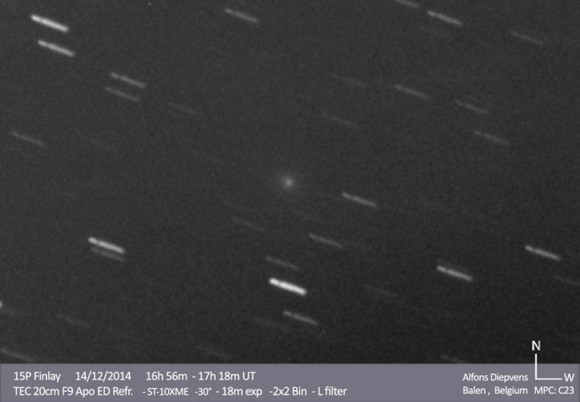
Looking at the map above it’s amazing how closely the comet’s path parallels that of Mars this month. Unlike Comet Siding Spring’s encounter with that planet last October, Finlay’s proximity is line of sight only. Still, it’s nice to have a fairly bright planet nearby to point the way to our target. Mars and Finlay’s paths intersect on December 23rd, when the duo will be in close conjunction only about 10? apart (1/3 the diameter of the Full Moon) for observers in the Americas. They’ll continue to remain almost as close on Christmas Eve. Along with Comet Q2 Lovejoy, this holiday season is turning out to be a joyous occasion for celestial fuzzballs!
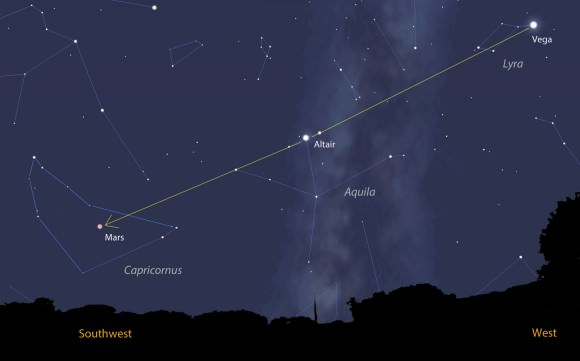
For those following all the habitability results from the Curiosity rover lately, here’s a special treat — the Discovery Channel will air a behind-the-scenes documentary on the mission tonight (Dec. 18) at 10 p.m. Eastern.
Continue reading “Curiosity Mars Rover Stars In Discovery Television Documentary Tonight”

KENNEDY SPACE CENTER, FL – In a key test of rocket reusability, SpaceX will attempt a daring landing of their Falcon 9 first stage rocket on an ocean platform known as the “autonomous spaceport drone ship” following the planned Friday, Dec. 19, blastoff on a high stakes mission to the International Space Station (ISS).
The SpaceX Falcon 9 rocket carrying the Dragon cargo freighter is slated to liftoff on its next unmanned cargo run, dubbed CRS-5, to the ISS under NASA’s Commercial Resupply Services (CRS) contract. In a late development, there is a possibility the launch could be postponed to January 2015.
The instantaneous launch window for the Falcon 9/Dragon is slated for 1:20 p.m from Space Launch Complex 40 at Cape Canaveral Air Force Station in Florida.
As the Dragon proceeds to orbit, SpaceX engineers will attempt to recover the Falcon 9 first stage via a precision landing for the first time “on a custom-built ocean platform known as the autonomous spaceport drone ship,” according to a SpaceX statement.
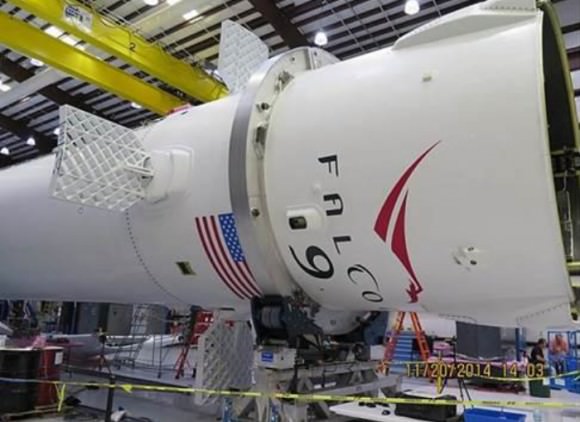
“While SpaceX has already demonstrated two successful soft water landings, executing a precision landing on an unanchored ocean platform is significantly more challenging.”
SpaceX rates the chances of success at “perhaps 50% at best.”
Of course since this has never been attempted before, tons of planning is involved and lots can go wrong.
But this is space exploration, and it’s not for the meek and mild.
It’s time to go boldly where no one has gone before and expand the envelope if we hope to achieve great things.
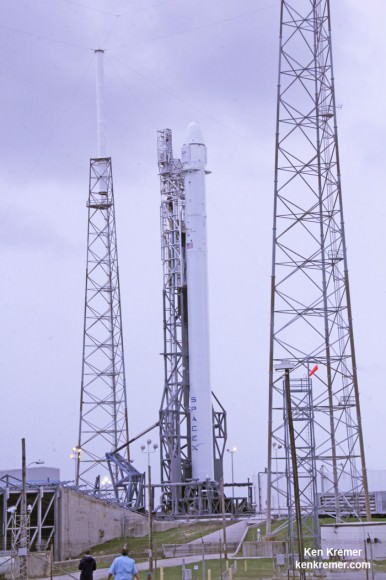
The 14 story Falcon 9 will be zooming upwards at 1300 m/s (nearly 1 mi/s). Engineers will then relight the Merlin 1D first stage engines to stabilize and lower the rocket.
Four hypersonic grid fins had been added to the first stage and placed in an X-wing configuration. They will be deployed only during the reentry attempt and will be used to roll, pitch, and yaw the rocket in concert with gimballing of the engines.
Here’s a description from SpaceX:
“To help stabilize the stage and to reduce its speed, SpaceX relights the engines for a series of three burns. The first burn—the boostback burn—adjusts the impact point of the vehicle and is followed by the supersonic retro propulsion burn that, along with the drag of the atmosphere, slows the vehicle’s speed from 1300 m/s to about 250 m/s. The final burn is the landing burn, during which the legs deploy and the vehicle’s speed is further.”
“To complicate matters further, the landing site is limited in size and not entirely stationary. The autonomous spaceport drone ship is 300 by 100 feet, with wings that extend its width to 170 feet. While that may sound huge at first, to a Falcon 9 first stage coming from space, it seems very small. The legspan of the Falcon 9 first stage is about 70 feet and while the ship is equipped with powerful thrusters to help it stay in place, it is not actually anchored, so finding the bullseye becomes particularly tricky. During previous attempts, we could only expect a landing accuracy of within 10km. For this attempt, we’re targeting a landing accuracy of within 10 meters.”
Watch for Ken’s ongoing SpaceX launch coverage from onsite at the Kennedy Space Center.
Stay tuned here for Ken’s continuing Earth and planetary science and human spaceflight news.
………….
Learn more about SpaceX, Orion, Antares, NASA missions and more at Ken’s upcoming outreach events:
Dec 18: “SpaceX CRS-5, Orion EFT-1, Antares Orb-3 launch, Curiosity Explores Mars,” Kennedy Space Center Quality Inn, Titusville, FL, evenings
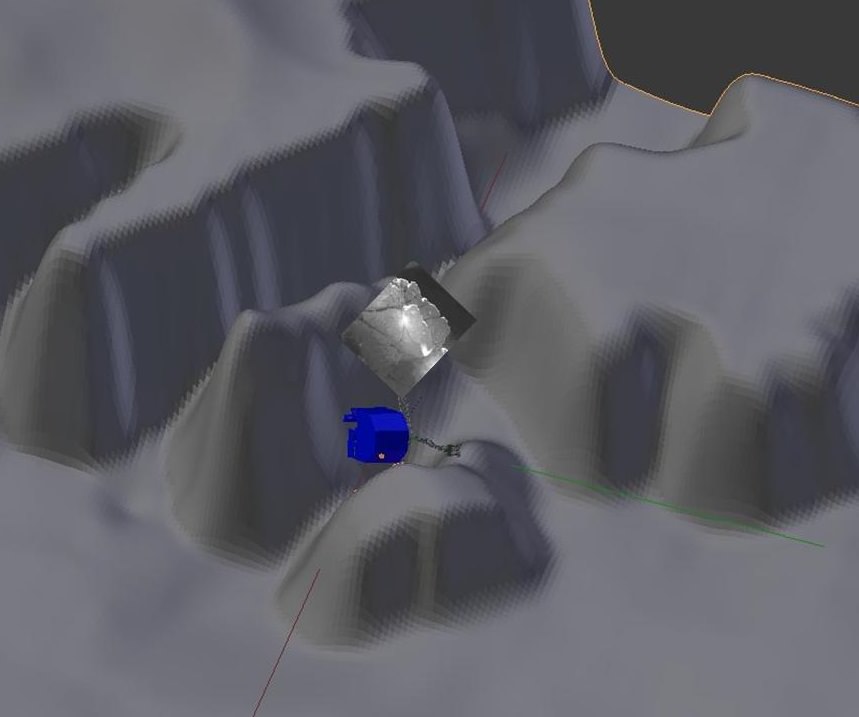
In scientific style, researchers are slowly narrowing down where the Philae lander arrived on Comet 67P/Churyumov-Gerasimenko. Earlier today (Dec. 17) at the American Geophysical Union meeting, more pictures from the European spacecraft were released showing its landing site and also what the terrain looked like underneath Philae as it bounced to its destination. The pictures were also placed on NASA’s website.
The lander is sleeping in a shady spot on the comet’s surface after the dramatic touchdown — actually, three touchdowns — on Nov. 12, when it flew for more than two hours across the surface and bounced as high as two miles (3.2 kilometers). This was partly because harpoons expected to secure it to the surface failed to deploy, and also because the comet crust was icier than expected, according to Gizmodo.
You can see in the diagram above Philae’s predicament; it’s wedged in a spot that doesn’t get a lot of sunlight, at least for now. That could change as 67P draws closer to the Sun in the late winter or early spring, but nobody yet knows for sure. And yes, the search for the landing site still continues in earnest, but the challenge now is the orbiting Rosetta spacecraft only has so much bandwidth to send back images, according to Wired. As more high-resolution OSIRIS (Optical, Spectroscopic, and Infrared Remote Imaging System) pictures arrive, scientists hope to figure out where it went.
Two pictures from Philae highlighted in today’s release are below. Will the lander take more? Scientists certainly hope so, but even if that doesn’t happen, the lander was only expected to return 20% of the science results in any case. Rosetta is still active and will stick with the comet through mid-2015, when 67P gets closest to the Sun.
